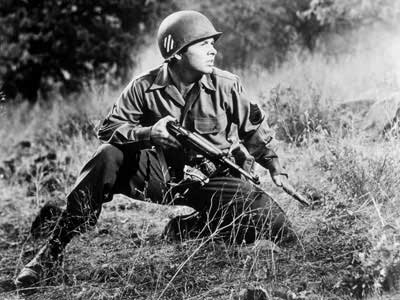The M1 Carbine was one of the most widely produced of all U.S. Military rifles. Here’s how to get your own piece of shootable history! READ MORE
Robert Sadowski
Millions of M1 Carbines were produced. This firearm served during World War II, the Korean War, and Vietnam War, and at one time surplus models were commonly found and inexpensive. Today things are different. A well-used, vintage M1 Carbine is expensive and the cost will vary dramatically depending on which manufacturer produced the M1 Carbine and the model. I collect, but I shoot what I collect and that’s why the M1 Carbines from Inland Mfg. and Auto-Ordnance are important to me and other shooters who favor the M1 Carbine.
AVAILABILITY
The Inland Mfg. M1 1945 Carbine ($1062) and Auto-Ordnance M1 Carbine Paratrooper ($805) are reproductions of carbines built in the mid 1940s. The Inland is a copy of the last style of Carbine built for the Military. The Auto-Ordnance (A-O) is a copy of the Model M1A1 designed for Paratroopers with a folding wire stock. These reborn Carbines offer a lot for collectors, competitive shooters, and home defenders.

The Inland Mfg. M1 1945 Carbine is made with an investment cast receiver mated to an 18-inch barrel with 4 grooves and a 1:20 inch twist rate. Features that make the Inland historically accurate are numerous and include the type 3 bayonet lug and barrel band, a rear sight with a siding ramp, and a push button safety. Original M1s had a flat bolt, basically the top of the bolt was milled flat. Late models used a round bolt to reduce manufacturing time. These features are also incorporated into the Inland carbine. The walnut stock is also referred to as a “low wood” stock which means it is relieved next to the operating slide. Early M1s had wood nearly covering the slide and the wood was prone to splitting in this area. From a historical perspective, the Inland was a good copy of the original carbine.

 The A-O is a reproduction of the Model M1A1, which was a model variant specifically designed for paratroopers who required a shorter weapon. Like early original M1A1s the A-O had no bayonet lug and the stock was close to originals even down to the brass rivets that attached the leather cheek rest to the wire stock. Sights were per the original a simple flip up aperture with a two settings one for 150 yard and the second for 300 yards. Windage was drift adjustable.
The A-O is a reproduction of the Model M1A1, which was a model variant specifically designed for paratroopers who required a shorter weapon. Like early original M1A1s the A-O had no bayonet lug and the stock was close to originals even down to the brass rivets that attached the leather cheek rest to the wire stock. Sights were per the original a simple flip up aperture with a two settings one for 150 yard and the second for 300 yards. Windage was drift adjustable.
The stock does not lock in an open or closed position. A detent keeps the stock in position and when I fired using the stock I could easily knock it out of the open position. This is a feature of this older design. The rest of the stock was plain walnut, and pistol grip is thick and filled my hand.
Magazines are easy to find and inexpensive from $8 to $35 depending on manufacturer and capacity. Carbines were originally issued with a 15-round magazine, and 10-, 15- and 30-round magazines are the most commonly available.
AMMO & PERFORMANCE
There is no shortage of .30 Carbine ammo. I had on hand quite an assortment: Hornady Critical Defense with 110-grain FTX bullets ($33/20-rnds), Hornady 30 Carbine with 110-grain Full Metal Jacket (FMJ) bullets ($39/50-rnds), Aguila 110-grain FMJs ($24/50-rnds), and steel-case TulAmmo also with 110-grain FMJs ($15/50-rnds). If you see the trend, the .30 Carbine’s sweet spot is the 110-grain bullet.

These modern reproductions are lithe and fast handling. Using the Inland Mfg. M1 1945 Carbine at 100 yards the Aguila ammo performed well and I fired my tightest 3-shot group which measured 2.05 inches. The TulAmmo ammo and Hornady Critical Defense also gave good accuracy averaging close to 2.75 inches on average. In fact I was quite pleased with the results since I were using iron sights and a mil-spec style trigger. The trigger is a single stage with some creep that broke at 6.1 pounds. Typical service style trigger.

Recoil is mild with not a lot of muzzle blast. At 25 yards fast follow up shots were quick. Since the rifle is only 36 inches long it is easy to maneuver.
In my opinion, the Inland is well suited for Civilian Marksmanship Program (CMP) M1 Carbine Matches. These matches are fired at 100 yards in 4 stages with slow and rapid fire and from prone, standing, sitting or kneeling.
At 25 yards I shot a near perfect, 3-shot clover leaf with A-O using the inexpensive TulAmmo. Recoil was more noticeable with the A-O since the cheek against the wire stock was not as comfortable. I was able to shoot a 2.0-inch 3-shot group at 100 yards with inexpensive TulAmmo; 2.1-inch best groups were obtained with Aguila and IWI. On averaged I achieved 2.3 to 2.8 inch groups at 100 yards with three shots. The trigger pull weight averaged 7 pounds but I still was able to shoot some decent groups.
As a home defense weapon or truck rifle, the new breed on M1 Carbines from A-O and Inland Mfg. are good choices. There are less-expensive options available, but they are not “as-original” M1 Carbines.

For more information on Auto-Ordinance click HERE
For more information on Inland Manufacturing click HERE











